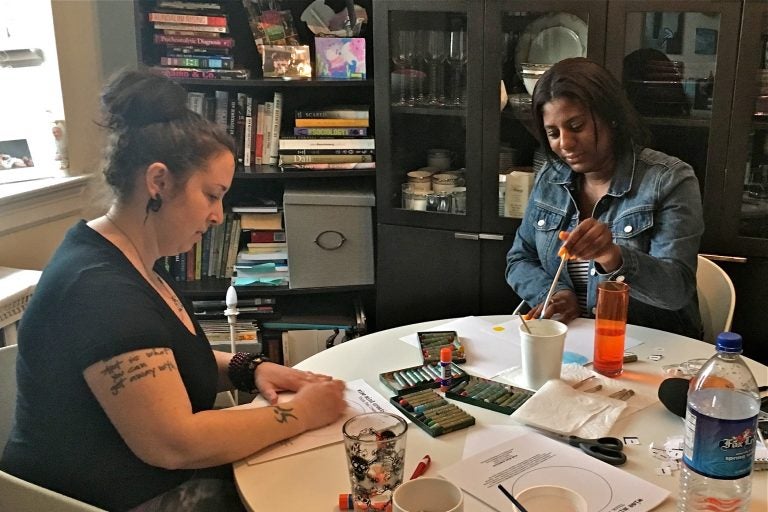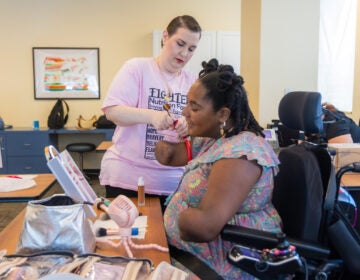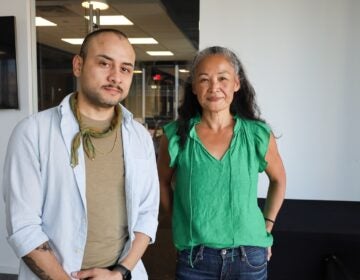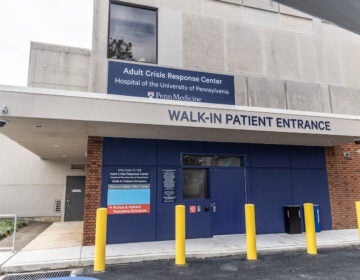Spacing out or guarding against trauma? Philly teen finds self-care in dissociation
Derricia Smith, 17, reflects on her experience with an elegant safeguard of the mind when it faces trauma, in this essay for Philly Audio Diaries.
Listen 5:12
Art therapist Jessica Masino Drass (left) works with Derricia Smith. (Anne Hoffman)
Research has found that about half of children in the U.S. have experienced at least one traumatic event before they turn 17. In Philadelphia, 17-year-old Derricia Smith recently found out about an elegant safeguard of the mind when it faces trauma.
—
“Derricia, is you listening?”
“Helllloooo?”
“Hey, I’m over here!”
People say these things to me all the time.
Like the other day, my sister was telling me something. “Derricia,” she said, “I’m not sure what to do. One of my friends is pregnant, and she’s scared to tell her mom. She said her mom isn’t gonna take it too well.”
In my mind, images flashed. I imagined the girl’s mom beating her.
Then I drifted away into my mind somewhere.
“Derricia,” my sister said, irritated, “you never listen to me!”
And she walked out.
I sat in the room by myself thinking, “Why do I keep doing this to people? Can this be stopped?”
Then I heard about dissociation.
It’s still hard for me to say the word, but it’s easy for me to understand. I’ve been dissociating, or spacing out, since I was small.
According to the American Psychiatric Association, symptoms of dissociation include a sense of detachment and “feeling as if one is outside one’s body.”
So dissociation is a reaction to trauma. I don’t want to go into detail about what I’ve been through, but it’s been a lot. When I dissociate, it feels like a daydream.
One of my mentors, Katie Davis, calls dissociation an “elegant safeguard of the mind when it faces trauma.” Elegant, because dissociation protects me from painful memories, from depression, from emotional overwhelm.
“It’s to comfort us, to protect us, right? And to make it so that you feel OK,” says Jessica Masino Drass, an art therapist who studies dissociation.
During my spring break, I went to visit her in her apartment in South Jersey. She has art supplies hidden in drawers and corners, books everywhere, and chart paper with psychological concepts on the walls.
Most importantly, Masino Drass helped me realize that dissociation is normal.
A lot of therapists and case workers have told me, “Derricia, you have major depression or PTSD.” But Jessica told me something different.
She told me that, actually, everyone dissociates.
“So it’s where our mind goes. It is a way to protect us and take care of us, right? Our body is present, but just like if you’re going to get a flu shot, you think about something else, right? You may not go and stare intently at, you know, the nurse or the doctor giving you the injection. You may, like, look up, or kind of go somewhere else. So it takes us out of our physical body to protect us,” she explained.
I was relieved. She told me that highway hypnosis, daydreaming — these are examples of dissociation.
Masino Drass told me that it’s actually natural to dissociate in the face of danger. It’s normal. So in other words, maybe there’s nothing wrong with me. Maybe I’m actually a really normal person who has just been through a lot.
“As we uncover this stuff, we want to respect these processes that our body did naturally, to take care of us. I don’t think there’s any magic way to do this,” she told me as she took out some oil pastels.
Soon, we were making art together.
She told me to draw, and not even think about it.
“This type of process could be a way to check in,” she said. “Even if we notice those moments of zoning out, maybe do a little 10-minute check-in. See what happens. You don’t have to figure it all out in that moment.”
She asked me to pick out some words, and the word I picked was “heavy.” I do feel heavy a lot. I feel like I’ve just got a lot going on. Like I’m holding everything. It feels like a burden, which is why I believe I dissociate sometimes, to get some relief.
Next, I drew a few different pictures on one sheet of paper.
I drew a sunny day, then a really rainy day, and a cloudy day.
I explained to her that the sunny day stood for me trying to stay positive. The cloudy day stood for when I’m going through something, but I manage to stick it out through the pain. And I explained that the last drawing I did was the rainy one, that describes how I feel once I get to the point that everything is way too overwhelming and I’m just ready to just give up.
She told me my images connected to my life, and that was a good thing.
“This is what mindfulness is,” she explained. “It’s how can we find connection from ourselves to the world around us. How do we find connection to something greater than ourselves?”
She continued.
“And actually, what did you say to me earlier?”
I remembered that I told her earlier that people at my school, El Centro de Estudiantes, have encouraged me to write a book about my life. But I haven’t done it — because I don’t want to go into detail about some of my worst memories.
“What did you tell me? Everyone keeps telling you to write a book, to write a story.”
And what did you just do?”
I wrote a story, I realized — a new story.
Derricia Smith, Anne Hoffman, Katie Davis, and Sandy Fleurimond collaborated on this story for Philly Audio Diaries, a program that teaches young people how to tell stories and record their lives. Philly Audio Diaries is part of CultureTrust Greater Philadelphia. The program is made possible with support from The Mayor’s Fund for Philadelphia.
WHYY is your source for fact-based, in-depth journalism and information. As a nonprofit organization, we rely on financial support from readers like you. Please give today.




